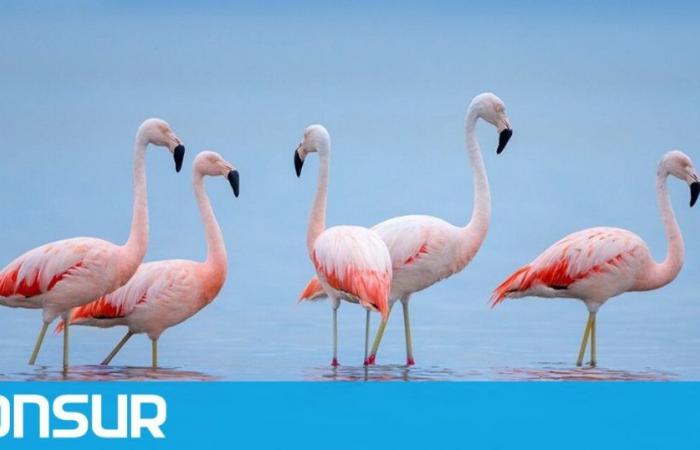For much of the year, those who walk through the beaches of Chubut They can see hundreds of flamingos, a bird that is impossible to go unnoticed, not only because of its size, but also because of its beauty.
Beyond contemplating them, it is also good to know a little more about this species and that is why Luciana Musmeci, researcher of Institute of Diversity and Southern Evolution (IDEAus-CONICET), explains some of the characteristics of these animals:
“The species we have in the area is the Southern Flamingo (Phoenicopterus chilensis). In general they are associated with different types of wetlands and our intertidal areas are included within these wetlands, where they have the availability of food they need. In general They eat small invertebrates including crustaceans, insects, larvae, and also small algae, among others. They have small lamellae and a conical tongue on their beaks that allow them to filter, which is why you see them moving with their legs and oscillating their heads and beaks.
Alert for snowfall and winds of more than 100 km/h in Chubut: which cities will be affected?
Their characteristic pink plumage is due to their diet rich in carotenoids, they have yellow eyes and greyish legs. Another characteristic is that they are webbed, that is, they have interdigital membranes that allow them to be in this type of soft environment and not bury themselves. And, despite their large size, they only weigh between 1.8 and 3 kilos.
The flamingos use both the beaches of Madrid and those of Peninsula Valdés, the lagoons and water bodies in the interior of the province to feed. At the moment Chubut has two colonies of flamingos (breeding places): one of them is located in Rawson, in a lagoon located within the municipal ejido, and the other in the Laguna Aleusco Protected Natural Area, in the northwest of the province about a hundred kilometers from the city of Esquel.
The two most affordable ski resorts in Patagonia: Which ones are they and how much does a ski pass cost?
“They reproduce in brackish lagoons because there they can build nests with mud, they make conical structures where they lay a single egg. Once the chick is born, it remains there for five to ten days, where the adults feed it something called crop milk. Afterwards, the chicks leave the nest and form groups called nurseries, which are always associated with a responsible adult who takes care of them,” says the CENPAT specialist.
In the wetland that houses the colony located in the provincial capital, up to 13,000 specimens were counted and up to 6,000 flamingo nests have been recorded, a true pink tide, while on the beaches of the city of Puerto Madryn they are found in groups which vary between about 100 and 300 individuals.
Violence in Comodoro: a young woman ended up with her face disfigured outside a nightclub
According to the latest evaluation of the Red List of Threatened Species of the International Union for Conservation of Nature (IUCN), held on August 9, 2018, Phoenicopterus chilensis It is listed as “Near Threatened” where a downward trend in its population is reported, and in Argentina the species has been categorized as “Vulnerable” by the Ministry of Environment and Sustainable Development of the Nation in conjunction with Aves Argentinas.
Among the main threats affecting the southern flamingo are energy production and mining, hunting and capture, modifications to the natural system, such as dams, and human intrusions and disturbances. The latter is the one that most affects the specimens living in the area of Rawson and Puerto Madryn: “The recommendation is not to disturb them. They are here because they choose to be, but if we create a continuous disturbance they may choose to go feed on another beach. People get too close to try to get a better photo, but if we respect the distance, they stay there feeding and we can watch them and enjoy them in the same way,” Musmeci concludes.


